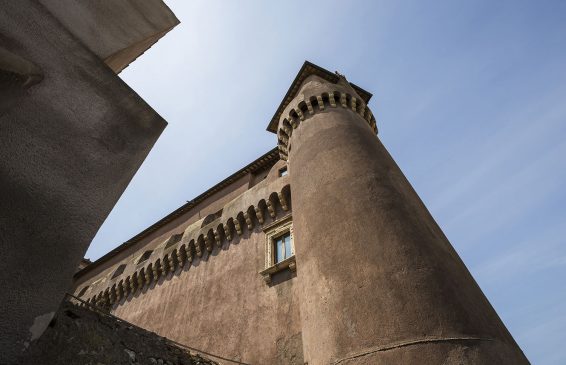
THE FORTRESS
On the remains of an early medieval fortalice, inside which the oldest church of Santa Severa was located, stands the fourteenth-century Fortress. The structure, surrounded by a moat, is characterized by the presence of four corner towers, two rectangular and two cylindrical, and a cylindrical donjon that is connected to the structure by a wooden walkway.
With a 20 metre height and an about 800 square metre internal surface, the Fortress has undergone several renovations over the years before reaching its current shape. Inside the Fortress there are three distinct levels (ground floor, first and second floor) in which the Castle Museum is set up; it’s a museum itinerary that hosts an exhibition of the most important finds brought to light in the area of the Fortress courtyard.
The finds came from the recent excavations held in conjunction with the restoration work and supervised by the Superintendence and volunteers of the “Gruppo Archeologico del territorio Cerite”. The museum has been enriched by illustrative panels, blow-ups, video-projections and 3D reconstructions of environments, instruments, weapons and ancient technologies telling the history and life of the castle, its village and its estate, from the Etruscan era to the martyrdom of Santa Severa, passing through the Roman and medieval ages up to the present day.
New “museums” to visit: the internal chapel of the Fortress, the hall with the frescoes of the era of Pope Urban VIII and the two circular corner towers of the south side of the Fortress. Thanks to an anthropological investigation on the medieval cemetery conducted by the University of Torvergata, it is possible to admire the reconstructions of faces and customs, food, diseases, life and death of the population who lived in the medieval age in the castle.
The noble Roman families that owned the castle: from the Tintosi to the Bonaventura Venturini to the Di Vico, a reconstruction of the kitchen and the medieval canteen with the remains of the meals and the original objects found during the excavations; the seal of Pietro Romano Bonaventura. Inside the Fortress, in addition to the Museum, multi-purpose spaces have been planned to host temporary exhibitions and other cultural activities. From the 2nd floor, through the top of the corner tower you pass on the wooden bridge that joins the Rocca to the ancient Saracen Tower “Maschio” of the castle.
THE SARACEN TOWER
The Saracen Tower is the oldest element of the castle of Santa Severa, dating back to the IX century, mentioned in documents from the XI and XII centuries. It has undergone continuous redevelopment until it reaches us in its structure of the XVI or XVII century. Formerly known as “La Torre del Castello”, it took on the new name in the modern era given during the restoration of the 1960s.
The name of the cylindrical building is due to its function of control of the coast and sighting of the “Saracen” vessels in particular between the XVI and XVIII centuries. The top of the tower, aka “Norman”, had been decorated during the Renaissance with three orders of corbels and with drains. Later it was joined to the castle with a drawbridge that can be visited today at a height of 20 metres: the Fortress-Saracen Tower ensemble represents the real fortress, the castle par excellence.
This part of the settlement, in ancient times, was destined to the military functions of defence of the coast and of the surrounding suburb. The structure is internally composed of three superimposed circular rooms and a terrace, the Piazza d’Armi, that is accessible thanks to the dedicated itinerary in the guided tour. Therefore, you have the unique and special possibility of enjoying one of the most evocative moments of the visit thanks to the enchanting panorama that, in every period of the year and in every moment of the day, offers suggestive evocations.
[ngg_images source=”galleries” container_ids=”9″ display_type=”photocrati-nextgen_basic_imagebrowser” ajax_pagination=”1″ order_by=”sortorder” order_direction=”ASC” returns=”included” maximum_entity_count=”500″]